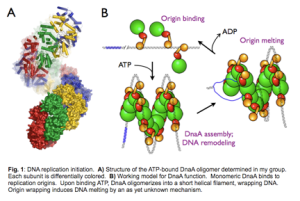
James M. Berger
Hunterian 716
Research Interests
My laboratory’s research is focused on understanding how multi-subunit assemblies use ATP for overcoming topological challenges within the chromosome and controlling the flow of genetic information. We are particularly interested in developing mechanistic models that explain how macromolecular machines transduce chemical energy into force and motion, and in determining how cells exploit these complexes and their activities for regulating the initiation of DNA replication, chromosome superstructure, and other essential nucleic acid transactions. Our principal approaches rely on a variety of structural, biochemical, and biophysical methods to define the architecture, function, evolution, and regulation of biological complexes. We also have extensive interests in mechanistic enzymology and the study of small-molecule inhibitors of therapeutic potential, the development of chemical approaches to trapping weak protein/protein and protein/nucleic acid interactions, and in using microfluidics for biochemical investigations of protein dynamics and structure.
Ongoing Project Areas
Replication initiation and replisome assembly. The initiation of DNA replication relies on a large and multi-faceted complement of proteins that coordinately recognize origin sequences, unwind the  origin DNA, and assemble the replisome. Initially, phylogenetic analyses suggested that replication factors fell into two general classes, bacterial and eukaryl/archaeal; however, structural and biochemical data have since indicated that nearly all initiation proteins share certain fundamental architectural and functional features. To better understand how cells regulate and initiate replication of their genomes, we are studying origin-binding proteins, helicases, primases, and accessory remodeling factors from a variety of organisms within the three cellular domains of life. Work from our group is revealing important information about the mechanisms of origin processing, primer synthesis, and macromolecular assembly that occur during replisome construction (e.g., see Fig. 1). We are biochemically and structurally dissecting the reaction cycles of these initiation proteins, both individually and complexed with various targets, to better understand their molecular and cellular function.
origin DNA, and assemble the replisome. Initially, phylogenetic analyses suggested that replication factors fell into two general classes, bacterial and eukaryl/archaeal; however, structural and biochemical data have since indicated that nearly all initiation proteins share certain fundamental architectural and functional features. To better understand how cells regulate and initiate replication of their genomes, we are studying origin-binding proteins, helicases, primases, and accessory remodeling factors from a variety of organisms within the three cellular domains of life. Work from our group is revealing important information about the mechanisms of origin processing, primer synthesis, and macromolecular assembly that occur during replisome construction (e.g., see Fig. 1). We are biochemically and structurally dissecting the reaction cycles of these initiation proteins, both individually and complexed with various targets, to better understand their molecular and cellular function.
Nucleic acid-dependent motors. The length and double-helical properties of DNA present the cell with topological and information processing challenges. For example, transcription and replication require melting of duplex DNA to read out the coded nucleotide sequence, while chromosomal tangles and knots can arise during replication, recombination, and DNA compaction. To resolve these problems, cells use a host of molecular motor proteins, including type II DNA topoisomerases, helicase/translocases, and chromosome-condensation assemblies to modulate and reorganize DNA or RNA superstructure. Many of these proteins utilize ATP, but direct it toward different purposes, such as transporting one DNA duplex through a transient break in another, or moving along a DNA or RNA chain while concomitantly unwinding paired nucleic-acid strands. Despite such significant functional differences, each of these proteins nonetheless uses ATP binding and hydrolysis to trigger cascades of conformational changes that result in motion and force generation. We are currently studying a variety of DNA- and RNA-dependent motor proteins. Using structural and solution-based analyses of different conformational and substrate-bound states, combined with directed biochemical and enzymological studies, we are determining how such proteins interact with nucleic acids and partner proteins, and how they use ATP to drive the architectural changes required for catalysis and physical movement.
Selected Publications
